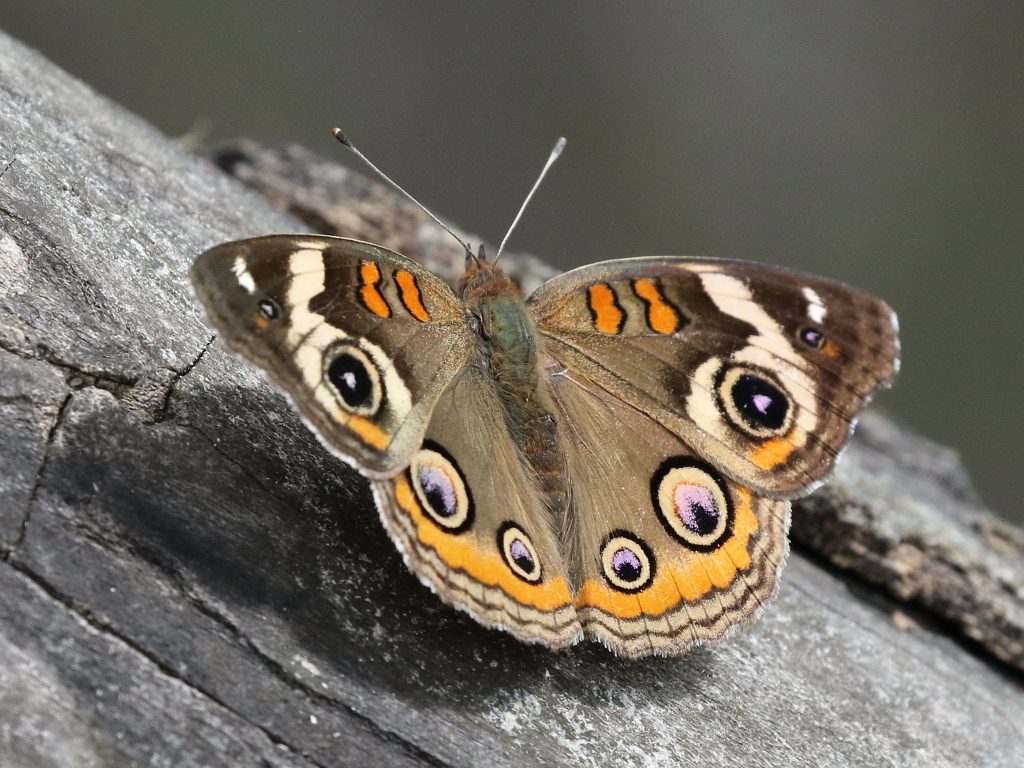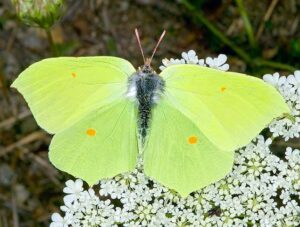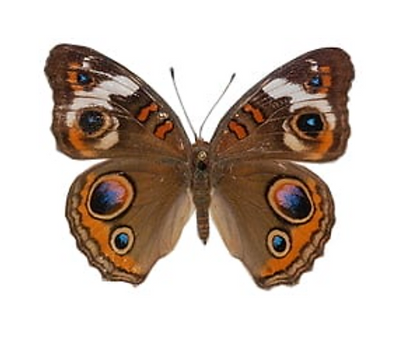
Size:39-68mm
Larva to 45mm
Identification
Upperside is brown. Forewing with 2 orange cell bars and 2 eyespots; part of white subapical band appears in the largest, lower eyespot. Hindwing has 2 eyespots; upper one is largest and contains a magenta crescent. Underside of hindwing is brown or tan in the wet season (summer) form and rose-red in the dry season (fall) form.
Caterpillar is highly variable in color, but usually “mostly black above and white and/or orange along sides with metallic blue-black dorsal spines. Spines along sides arise from orange wart-like bases. Head orange above with black bordering frons;short black scolus over each lobe…heavily salted with white tubercles”
- Wingspan: 32-60 mm
- Life Cycle: Egg: green, laid singly on host leaves Mature larva: black with white stripes marked with orange and numerous black branched spines Chrysalis: light brown with darker markings
Range
Resident in the southern United States and north along the coasts to central California and North Carolina; south to Bermuda, Cuba, Isle of Pines, and southern Mexico. Adults from the south’s first brood migrate north in late spring and summer to temporarily colonize most of the United States and parts of southern Canada.
Habitat
Open, sunny areas with low vegetation and some bare ground.
Habitat and Food Source(s): Caterpillars have chewing mouthparts. Adults have siphoning mouths. Caterpillars eat leaves of broad-leaved weeds including gerardia, false loosestrife, monkey flower, plantain, snapdragon, stonecrop, toadflax and Verbenaceae. Butterflies are found in open areas where they make shots flights between stops where they rest on the ground, holding their wings out while basking. Adults frequent flowers and feed on nectar.
Food
Caterpillar hosts: Plants from the snapdragon family including snapdragon (Antirrhinum), toadflax (Linaria), and Gerardia; the plantain family including plantains (Plantago); and the acanthus family including ruellia (Ruellia nodiflora).
Adult food: Favorite nectar sources are composites including aster, chickory, gumweed, knapweed, and tickseed sunflower. Dogbane, peppermint, and other flowers are also visited.
Life Cycle
Males perch during the day on low plants or bare ground to watch for females, flying periodically to patrol or to chase other flying insects. Females lay eggs singly on leaf buds or on upperside of host plant leaves. Caterpillars are solitary and eat leaves. Caterpillars and adults overwinter but only in the south.
Larvae and adults overwinter. Female butterflies lay eggs on host plants and caterpillars develop through several stages (instars) before forming a chrysalis (pupa). Three to four generations are produced annually.
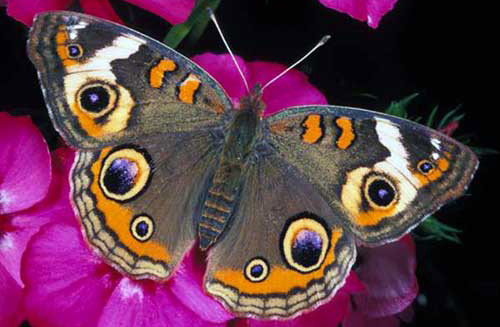
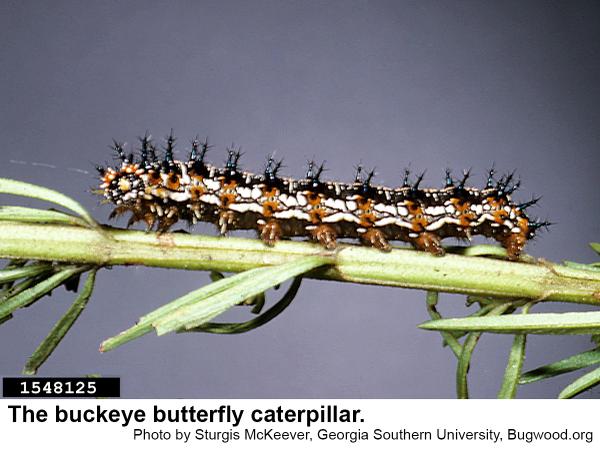
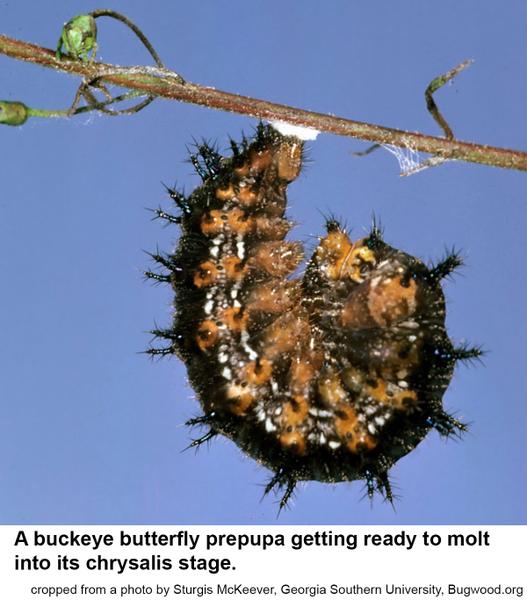
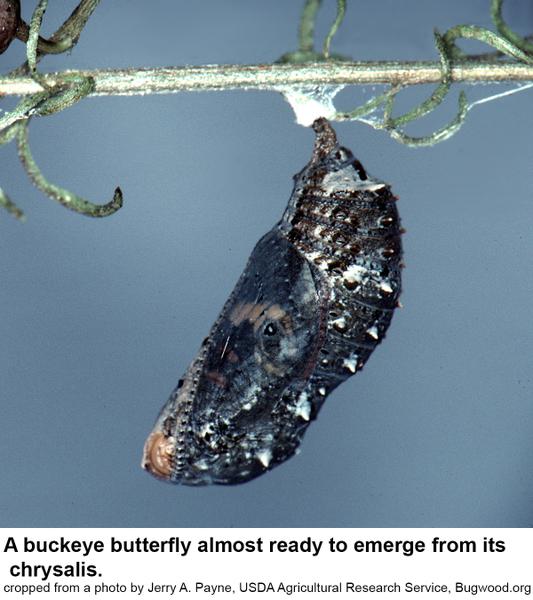
Host Plants
Buckeye caterpillars are solitary and mostly feed on the weed plantain and on Gerardia, grown for its showy flowers. It also feeds on snapdragon, toadflax and other native weeds. Buckeye butterflies visit numerous weedy and ornamental flowers.
Residential Recommendation
Skip to Residential Recommendation
Because plantain is not a particularly desirable plant in the landscape, should buckeye caterpillars be noticed on it, no control seems necessary. When buckeye caterpillars are found causing actual damage to snapdragon or Gerardia, use Sevin or some other insecticide labeled for use in the landscape.
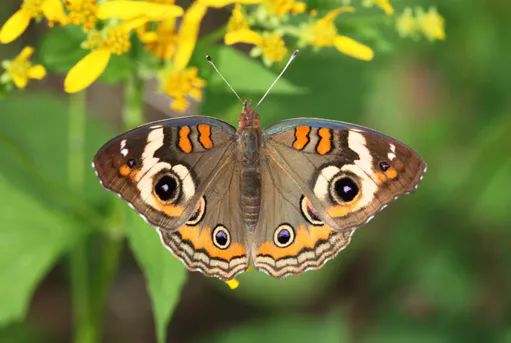
- Number of Generations: 3 or more per year
- Flight Season: All year
- Abundance: Common
- Habitat: Forest margins, beaches, pastures, wet meadows, old fields, disturbed sites, roadsides, gardens
- Larval Host Plants: Plantain (Plantago spp.), False Foxglove (Agalinis fasciculata), Florida Toadflax (Linaria floridana), Blueheart (Buchnera americana), Twinflower (Dyschoriste oblongifolia), Frogfruit (Phyla nodiflora)
- Similar Species: No similar species
- Additional Information: Migratory; adults overwinter in reproductive diapause. Range is limited in Colorado, Nevada and Oregon.
- Family name: Nymphalidae/Brush-Footed butterflies
- General description: Forewing brown with two orange cell bars and a white subapical band enclosing a single large eyespot; hindwing brown with to large eyespots and an orange submarginal band. Ventral hindwing seasonally variable; summer form (wet season) individuals light brown with a darker postmedian band including several small dark spots; winter form (dry season) individuals reddish-brown with less conspicuous pattern elements.
- Field Marks: forewing brown with two orange cell bars and a white band enclosing a single large eyespot; hindwing brown with two large eyespots and a orange submarginal band. Ventral hindwing mottled brown to red.
Common Name:Buckeye
The Buckeye occurs at all our sites but is non-resident above 5000′. At Lang it has overwintered successfully, but clearly not every year. It is not certain that it ever overwinters at Sierra Valley. In some years, e.g. 2005, there are massive waves of immigrants in early summer. We do not know where they come from. In such years the peak density may be reached in midsummer, as Buckeye reproduction temporarily outstrips the capacity of natural enemies to control the population. The Buckeye breeds continuously in warm weather. Usually the population peaks in autumn. At that time females become very dispersive, blanketing the landscape with eggs. If overwinter survival is a sort of lottery, local “winners”-distributed sporadically-will be the foci from which the population will re-expand in spring to reoccupy the entire area. Evidence of local breeding on the floor of the Sacramento Valley often begins in late May or June. Overwinter survival is consistently better in the foothills than in the Valley. The great freeze of December 1990 extirpated this butterfly from our entire area, but it recolonized within a year.
In August, September and October the Buckeye produces a distinctive phenotype, “rosa,” with a deep red or reddish-purple color on the hindwing beneath. This is particularly striking in females. Although photoperiod has been implicated, it is clearly not the whole story since the “rosa” phenotype is never produced in spring. Late-autumn and early spring individuals are usually very small and plain clay-colored beneath.
Male Buckeyes are territorial perchers, usually on bare ground. Both sexes visit a great variety of flowers, from Heliotrope and Lippia to California Buckeye and Rabbitbrush! They often swarm over Coyotebrush (Baccharis) in autumn, especially the male plants.
This is a species of open country, rarely entering the woods and then only along roads or streams.
The Buckeye has been used for developmental- biology studies of wing pattern determination. It is subject to often striking aberrations, some of which have been collected in our area. The most frequent of these has the white wing-band above obscured by brown scales, more or less resembling some subtropical and tropical Buckeye relatives. This phenotype formerly occurred rather often at Suisun, but has not been seen since the 1990 extinction.

